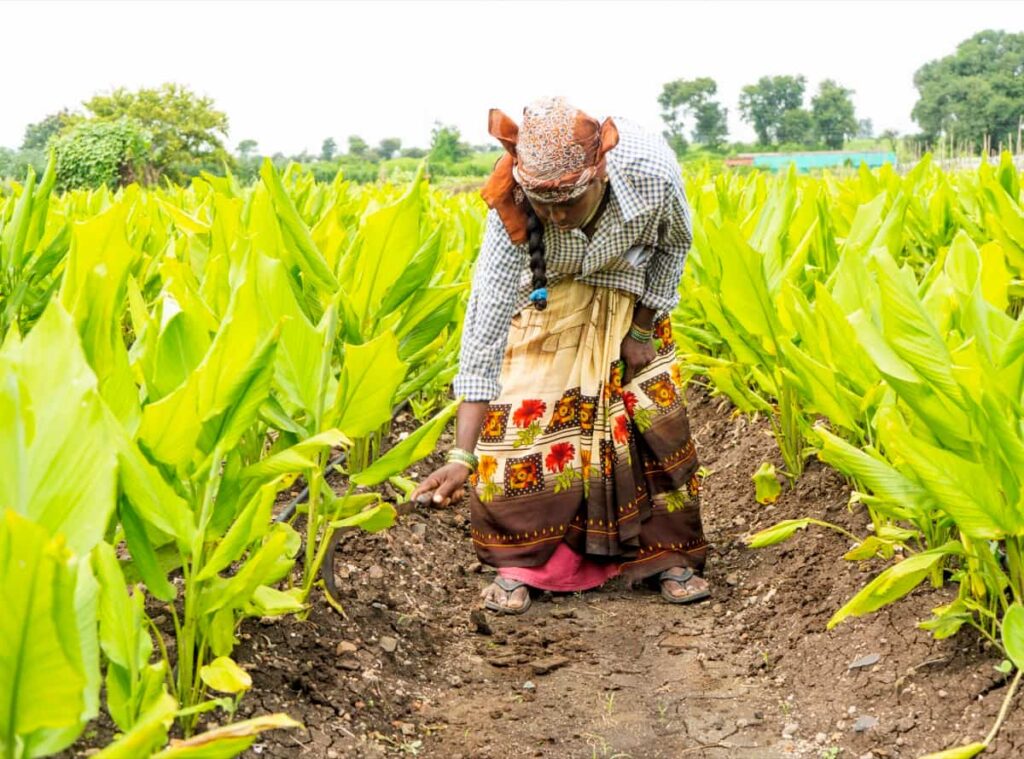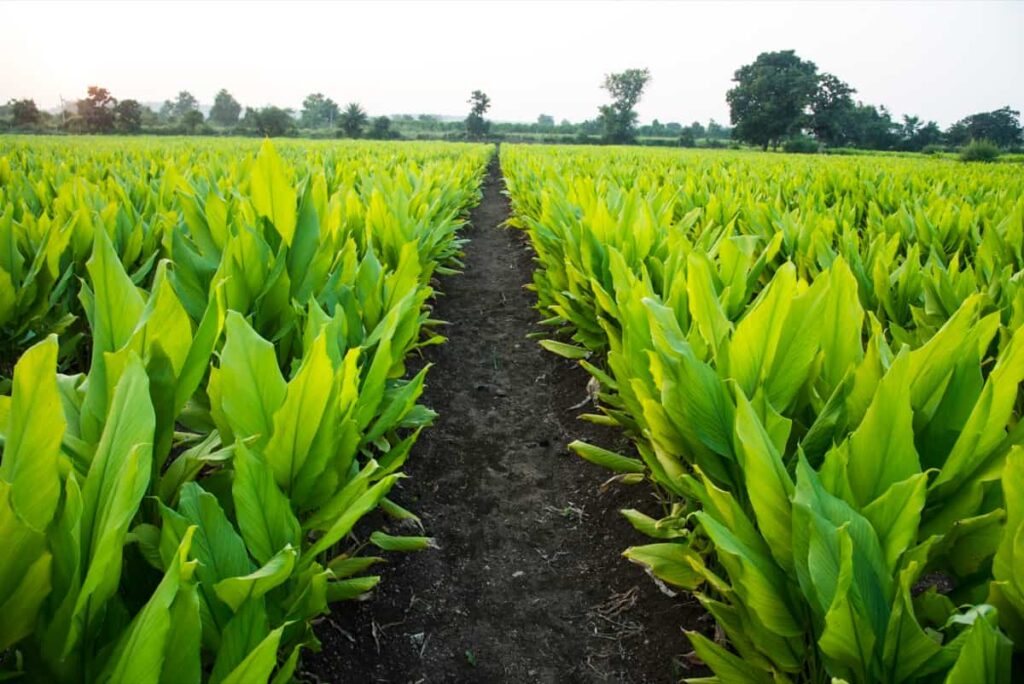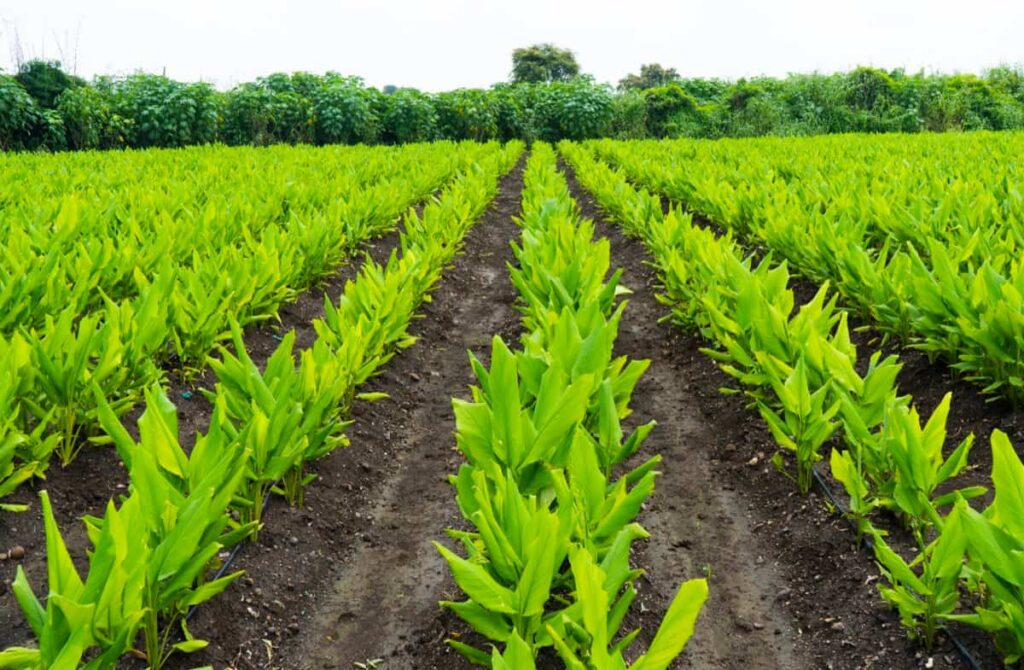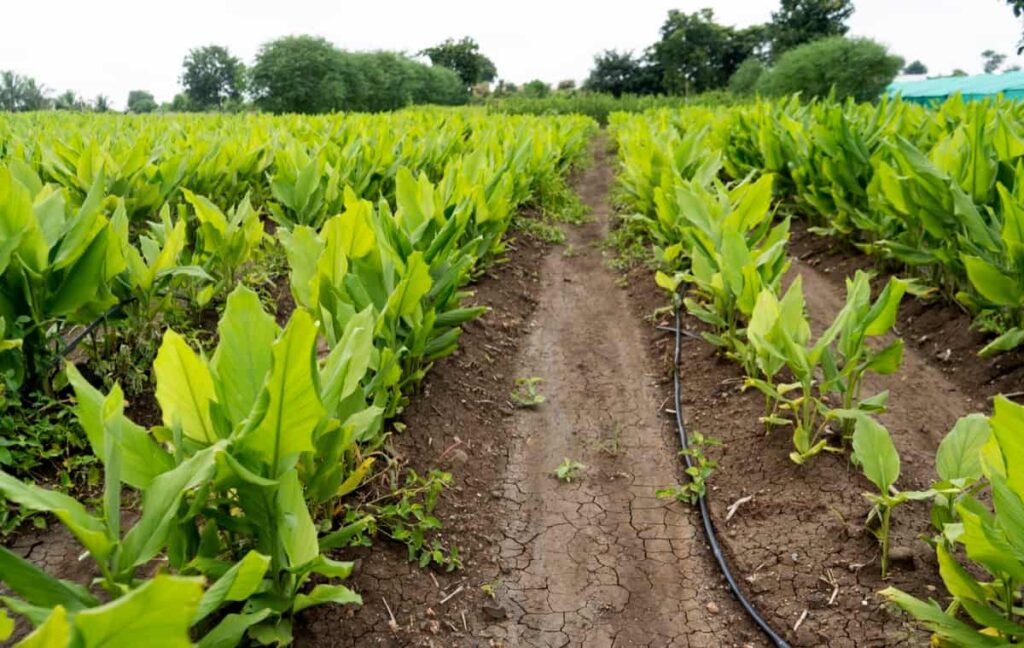Have you thought about starting your own turmeric business and being your own boss? If so, turmeric farming may be the perfect opportunity for you. Turmeric is a plant used for health benefits and as a spice in many cuisines worldwide. As the demand for natural and organic products grows, the turmeric market is expanding rapidly.

This guide provides all the necessary information to create a good turmeric farming business plan. From conducting market research and analysis to developing a farm plan and financial projections, we will cover everything you need to know to get started. Whether you are a farmer or just starting a business, this guide will give you the tools and resources to succeed in the turmeric farming industry.
Turmeric Farming Business Plan
Introduction to Turmeric Plant
Turmeric (Curcuma longa) is an incredible plant with a long and fascinating history. A perennial belonging to the ginger family ‘Zingiberaceae’, it is native to the Indian subcontinent and southeast Asia. The plant grows to a height of around 1 meter and has wide, green leaves.
- The plant part that is most commonly used is the rhizome, which is a stem that grows underground and sends out roots and shoots from its nodes. After 7 to 9 months of sowing, turmeric crops are ready for harvesting. The rhizomes can be used fresh, but they are typically boiled in water, dried, and then converted into a dark yellow powder.
- Turmeric powder is commonly used as a color and flavor enhancer in many dishes, particularly in Indian cuisine. The powder has a warm, bitter taste and a mustard-like aroma. It is also an important part of Ayurvedic and Siddha medicine and has been used for thousands of years in traditional Indian remedies.
- Turmeric cultivation requires temperatures between 20°C to 30°C (68°F to 86°F). Turmeric is a herbaceous plant, meaning it is a vascular plant that lacks any woody stems above the ground.
Benefits of Turmeric Farming
- High demand: The demand for natural and organic products, including turmeric, is rising.
- Profitability: Turmeric farming can be a profitable business venture due to its high demand and the potential to earn a good return on investment.
- Health benefits: Turmeric is known for its numerous health benefits and is used in various wellness products.
- Low maintenance: Turmeric is a low-maintenance crop that can be grown in various climates and soils.
- Diverse use: Turmeric can be used as a spice, food colorant, cosmetics, and pharmaceuticals.
- Sustainable farming: Turmeric farming is environmentally friendly and can be practiced using sustainable methods.
- Flexibility: Turmeric farming can be done on a small or large scale, making it an accessible option for farmers of all sizes.
In case you missed it: How to Start and Succeed with Microgreens Business Plan

How to Grow Turmeric and Production
Commercial cultivation requires knowledge of factors like the quality of turmeric, temperature, soil type, water testing, fertilizers, and care. By reading the information provided in the following paragraphs, you will be able to learn how to cultivate turmeric plants successfully, whether for commercial purposes or for growing at home.
Turmeric Varieties
Some popular varieties include Alleppey Finger, Erode, Madras, Rajapuri, and Salem. Each variety has distinctive features like color, flavor, and aroma. The selection of a variable depends on the intended use, growing conditions, and market demand.
Climate and Soil Required for Turmeric Farming
Turmeric farming requires a warm climate and well-distributed rainfall. The temperature for turmeric should be between 20°C to 30°C. Turmeric needs a lot of water and requires an assured water supply throughout the year, so it is mainly grown in regions with good rainfall. Well-drained, friable, sandy loam soil with high organic matter is considered the best for its cultivation.
The soil should have a pH between 4.5 to 7.5, with a good organic portfolio. Turmeric can grow in different soil types, including sandy loam, clay loam, red soil, and light black soil, but it is sensitive to waterlogging. Soil, 15-20 cm from the surface, should be friable so the rhizome can develop well.
Land Preparation for Turmeric Cultivation
- Plowing and harrowing: This is the first step in land preparation. It helps break down the soil, remove weeds, and throw tiny stones from the farm.
- Creating beds: Beds with a height of 15 cm and a width of 1 m should be created. The spacing between the beds should be 50 cm.
- Preparing ridges and furrows: Ridges and furrows are required for irrigation purposes.
- Planting rhizomes: The rhizomes should be planted in shallow pits on the top of the elevations.
- Spacing: The spacing between turmeric crops should be 45-60 cm between the elevation and 15-20 cm between the plants.
In case you missed it: Designing a Sustainable Future: Crafting an Effective Permaculture Business Plan

Process of Turmeric Plantation
Starting with land preparation, which includes plowing, harrowing, and the creation of ridges and furrows for irrigation. The next step is seed rhizome selection, which is then treated with bio-fungicides to prevent fungal infections. The rhizomes are planted in shallow pits on the ridges with proper spacing. After that, irrigation, weeding, and mulching are done.
Manure and Fertilizer in Turmeric Farming
The recommended amount of well-rotted cow dung is 2-3 tons per acre, which should be applied as a basal dose while planting turmeric seeds. Neem cake is also a great organic fertilizer for turmeric crops, which can be applied at a rate of 0.8 tons per acre. For better results, you can apply 30-40 tons per hectare of decomposed cow dung or Farm Yard Manure and 120 kg of N, 60 kg of P, and 60 kg of K per hectare.
Half nitrogen and the full amount of phosphorus and potash should be applied during the last plowing. The remaining half of nitrogen should be given in two equal parts at 45 and 90-day intervals after sowing the rhizomes.
Turmeric Crop Rotation
Turmeric can be rotated with crops like finger millet, rice, sugarcane, maize, ragi, wheat, pulses, chilies, onion, garlic, and ginger for better soil health and to prevent pests and diseases. Turmeric is rarely cultivated mixed with other crops like brinjal, tomato, green chilies, okra, castor, maize, and finger millets.
Turmeric Pests and Diseases
Diseases & Control
- Leaf Spot: This disease is characterized by brown spots on leaves during August and September. Control measures include selecting disease-free rhizomes for seed, drying rhizomes in the shade, and burning sick leaves. Spraying Indofil M-45 or Bavistin twice or thrice at 15 days can also help control this disease.
- Leaf Blotch Disease: This disease causes yellow spots on leaves during October and November. The diseased leaves curl up, turn brownish-reddish, and fall off later. Practicing crop rotation for three to five years and treating rhizomes with agalol or mancozeb solution before sowing is essential to control this disease.
- Rhizome Rot or Soft Rot: This disease is caused by several species of fungus called Pythium and affects the crop at the age of three months. The edges of the leaves turn yellow and dry up, and the plant dies. Control measures include treating rhizomes used for seed with agalol or mancozeb solution and removing affected plants.
In case you missed it: Building a Sustainable Future: A Comprehensive Guide to Developing Your Ecological Farming Business Plan

Pests & Control
- Rhizome Borer Pest: The main pest that damages the turmeric crop. Its caterpillar enters the stem and makes dead tissue, while its adult insect is pink-yellow with black stripes on the wings. Control measures include spraying 0.5% neem oil to destroy shoot borer and applying Rogar when dead hearts start appearing.
- Leaf Roller: This pest eats the folded leaves and lays eggs there. For prevention, spraying 1 ml of Rogar per liter is recommended.
- Scale Insect: This pest harms the plant by sucking the juice of the rhizome in the field and during storage. To prevent this, treat the rhizomes with 1 ml of Malathion or Rogar in 1 liter of water at the sowing time.
Turmeric Harvesting and Post-Harvest Operations
Turmeric harvesting usually occurs 7 to 10 months after planting, depending on the variety and climatic conditions. The leaves turn yellow, and the stems begin to dry, indicating that the crop is ready for harvesting. The rhizomes are dug out carefully using a spade or a fork and then separated from the stems and leaves. After harvesting, the rhizomes are cleaned, washed, and boiled in water for about 45 minutes to an hour. This process helps to remove any dirt and microbial contamination.
Then, dried in the sun or a dryer until the moisture content reaches around 10-12%. The dried rhizomes are then polished using a polishing machine or by hand to remove the outermost layer, giving it a shiny appearance. Finally, the turmeric is sorted and graded based on size, shape, and color. Post-harvest operations involve proper storage of turmeric to prevent it from getting spoiled or damaged. The turmeric is stored in a cool, dry, well-ventilated place away from direct sunlight.
Project Report on Turmeric Cultivation
Turmeric cultivation can be profitable if done with proper planning and execution. The total cost of turmeric cultivation per acre is around Rs 1,00,000-1,30,000, including seeds, manure and fertilizer, irrigation, plant protection charges, boiling, drying, polishing, and labor costs. The yield per acre of turmeric crop can vary from 18 to 24 quintals.
In case you missed it: A Comprehensive Guide to Crafting a Successful Shade Net Farming Business Plan

Taking the average yield of 18 quintals, the total income generated from selling the turmeric crop would be Rs 1,80,000-2,00,000, assuming the price of turmeric is Rs 75 per kg. The net profit from turmeric farming would be the income generated from selling the crop minus the total cost incurred in cultivation. In this case, the net profit comes to around Rs 66,800. It is important to note that the price of turmeric can vary depending on the market, place, season, and time.
Turmeric Farming Business Plan
To start a turmeric farming business, you must have a proper business plan. You should select land that has well-drained soil and proper irrigation facilities. Then, you need to purchase good-quality turmeric seeds and organic manure. After sowing the seeds, proper care should be taken by providing nutrients and protection from pests and diseases.
Once the turmeric is ready for harvest, it should be boiled, dried, polished, and packed properly. Finally, you can sell turmeric in the market or export it to other countries. A good marketing strategy can help you sell turmeric at a profitable price. You can create a successful turmeric farming business plan by following these steps.
Business Plan Components
- Executive summary: A business plan summary highlighting the key points.
- Company description: A detailed description of the turmeric farming business, including the location, size of the farm, and legal structure.
- Market analysis: An analysis of the market demand for turmeric, including the market size, competitors, and potential customers.
- Marketing and sales: A detailed plan for how the turmeric will be marketed and sold, including pricing, promotion, and distribution strategies.
- Products and services: A description of the turmeric products and services offered, including the quality of the turmeric, packaging, and any value-added services.
- Operations and management: A description of the day-to-day operations of the turmeric farming business, including the roles and responsibilities of employees and management.
- Financial plan: A detailed financial plan, including projected revenue, expenses, and profits for the first few years of the business.
- Funding requirements: A description of the funding required to start and grow the turmeric farming business, including any loans or investments.
- Risks and challenges: An analysis of the risks and challenges that may arise in the turmeric farming business and how they will be mitigated.
Market Research and Analysis
Market research and analysis are essential for any business, including turmeric farming. According to a report by IMARC Group, the global turmeric market reached a US$ 1.18 Billion in 2020. The market is expected to grow 5.6% from 2021-2026, reaching a US$ 1.67 billion value by 2026. India is the largest, biggest producer, consumer, and exporter of turmeric, accounting for more than 70% of the global turmeric production.
Other significant producers include Bangladesh, Pakistan, Sri Lanka, China, Indonesia, and Myanmar. The main export destinations of Indian turmeric are the UAE, the US, Iran, Malaysia, the UK, and Sri Lanka. Turmeric is used in various industries, including food, cosmetics, pharmaceuticals, and dyeing. The food industry accounts for most of the turmeric consumption, with spice being a key ingredient in curry powders, sauces, and marinades.
In case you missed it: Guide to Starting a Successful Medicinal Plants/Herbs Farming Business Plan: Tips, Strategies, and Best Practices

Conclusion
Creating a good turmeric farming business plan involves careful planning, market research, and financial analysis. Considering all the necessary components, such as target market, production costs, and marketing strategies, one can develop a successful plan to enter the turmeric farming industry and achieve profitability.
- Crops Grown in Summer Season: Best Choices for Summer Gardening
- Organic Pest Control for Tomato Farming
- How to Maximize Sheep Farming Profit
- Broccoli Varieties: Choosing the Right Cultivars for Your Farm
- How to Raise Pigs in Your Own Backyard: A Comprehensive Guide
- Budget Friendly Sheep Shed Ideas: Cheap and Low-Cost Tips
- How Much Do Cattle Farmers Make: Revenue Streams in Cattle Farming
- Management Pests and Diseases in Your Cotton Field
- Sheep Farming Business Plan for Beginners
- Aquaponic Farming at Home: A Step-By-Step Guide
- Profitable Village Farming Business Ideas in 2024
- High-Yield Aquaculture: Fast-Growing Fish for Farming
- Effective Fish Pond Construction Techniques for Beginners
- Irrigation and Water Management in Pineapple Farming
- Blossom to Harvest: Mastering Flowering and Pollination in Papaya Farming
- Pig Fattening Essentials: From Selection to Sale for Beginners
- Raising Wagyu Cattle: A Complete Guide for Premium Beef Production
- Soil Types and Their Water Holding Capacity
- Optimizing Irrigation Schedules for Coconut Groves for Enhanced Yield
- Espresso Your Garden: Coffee Grounds for Healthier Acid-Loving Plants
- The Best Soil Mix for Snake Plants: How to Mix Your Own Snake Plant Soil
- Green Thumb Success: Expert Tips for Cultivating Greenhouse Beans All Year Round
- Bloom All Year Round: The Ultimate Guide to Indoor Hyacinth Care
- Eco-Friendly Gardening: How to Make Liquid Fertilizer from Kitchen Waste
- Ultimate Guide to Grow Anise in Pots: Explore Seed Propagation to Harvesting
- Guide to Raising Chester White Pigs: Discover Breed Facts to Growth Management
- Mastering the Elegance: The Ultimate Guide to Weeping Cherry Tree Care, Planting, and Maintenance
- Ultimate Guide to Planting Garlic in Grow Bags: Growing Strategies for Beginners
- How to Fix Spider Plant Leaf-Related Problems: Natural and Organic Remedies
- 10 Reasons Why Your Tulsi Plant is Shedding Leaves: Home Remedies and Solutions
- Optimizing Growth and Yield: The Advantages of Palm Bunch Ash Fertilizer
- Utilizing Neem Oil Extract as a Natural Pesticide for Hydrangea
- From Soil to Harvest: Various Ways in Which Farmers Can Use AI Tools
- Steps to Encourage and Induce Citrus Flowers: A Comprehensive Guide
- How to Fix Snake Plant Leaf-Related Issues: Natural and Organic Remedies
- Transform Your Garden into a Fragrant Oasis with Raat Ki Rani (Night Blooming Jasmine)

I’m glad you stressed the value of promoting food and beverages with high-quality equipment and imagery so that customers will associate your brand with quality goods.
Awesome! Thank you for providing this important information. I strongly advise you to visit this site in order to learn more about Food and Beverage.